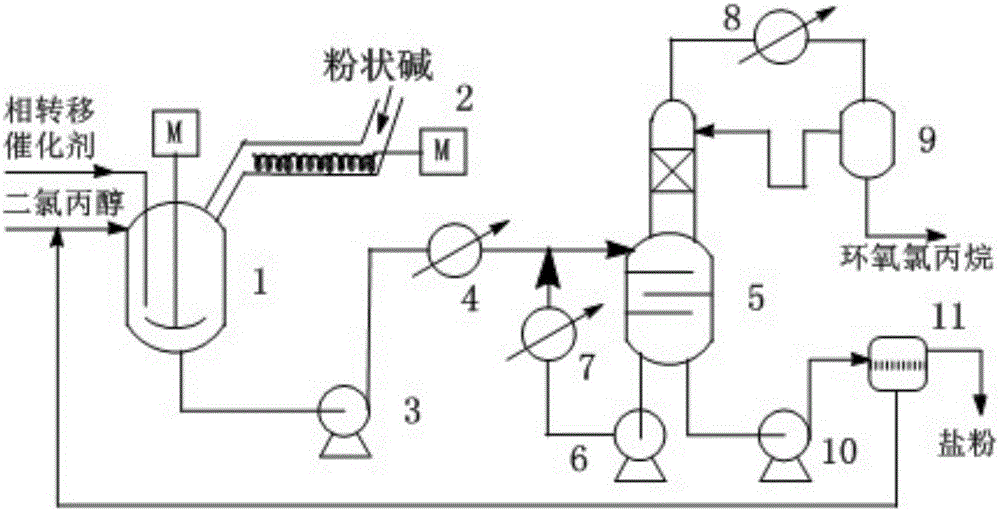Method for synthesizing epoxy chloropropane through phase-transfer catalysis
A technology of epichlorohydrin and phase transfer catalysis, which is applied in the direction of organic chemistry, can solve the problems of high energy consumption and high product cost, and achieve the effect of high purity
- Summary
- Abstract
- Description
- Claims
- Application Information
AI Technical Summary
Problems solved by technology
Method used
Image
Examples
Embodiment 1
[0027] Refer to attached figure 1 The flow process, in the reactant premix tank (1), dichloropropanol (weight composition: dichloropropanol 98%, hydrogen chloride 1%, water 1%) and phase transfer catalyst nonylphenol polyoxyethylene ether ( Molecular weight 650) mixes with the 58kg / h powdery potassium hydroxide (150 orders) input by powdery alkali feed pump (2), controls feed flow rate, makes dichloropropanol and The molar ratio of potassium hydroxide is 1.5:1, the weight ratio of nonylphenol polyoxyethylene ether to dichloropropanol is 0.005:1, and the average residence time of the materials in the premixing tank is controlled to be 20 seconds, and the mixing temperature is 35°C.
[0028] After the above materials are mixed, they are transported to the preheater (4) by the preheater feed pump (3) (indirect steam heating is adopted, that is, the material goes through the tube side, and the water vapor goes through the shell side), and the material after preheating to 50°C Aft...
Embodiment 2
[0033] Refer to attached figure 1 The flow process, in the reactant premix tank (1), dichloropropanol (weight composition: dichloropropanol 98%, hydrogen chloride 1%, water 1%) and phase transfer catalyst stearyl polyoxyethylene ether ( Molecular weight 1180) is mixed with the 41.5kg / h powdery sodium hydroxide (250 order) that is imported by powdery alkali feed pump (2), controls feed flow rate, makes dichloropropanol in the reactant premix still (1) The molar ratio to sodium hydroxide is 2:1, the weight ratio of stearyl polyoxyethylene ether to dichloropropanol is 0.006:1, and the average residence time of the materials in the premixing tank is controlled to be 30 seconds, and the mixing temperature is 35°C ,
[0034] After the above materials are mixed, they are transported to the preheater (4) by the preheater feed pump (3) (indirect steam heating is adopted, that is, the material goes through the tube side, and the water vapor goes through the shell side), and the materia...
Embodiment 3
[0039] Refer to attached figure 1 The process flow, in reactant premix tank (1), with dichloropropanol (weight composition: dichloropropanol 98%, hydrogen chloride 1%, water 1%) and phase transfer catalyst polyethylene glycol (molecular weight 2000) Mix with the 24.8kg / h powdery lithium hydroxide (350 orders) input by the powdery alkali feed pump (2), control the feed flow rate, make dichloropropanol and hydroxide in the reactant premix tank (1) The molar ratio of lithium is 3:1, the weight ratio of polyethylene glycol and dichloropropanol is 0.01:1, and the average residence time of the materials in the premixing tank is controlled to be 40 seconds, and the mixing temperature is 40°C.
[0040] After the above materials are mixed, they are transported to the preheater (4) by the preheater feed pump (3) (indirect steam heating is adopted, that is, the material goes through the tube side, and the water vapor goes through the shell side), and the material after preheating to 70°C...
PUM
 Login to View More
Login to View More Abstract
Description
Claims
Application Information
 Login to View More
Login to View More - Generate Ideas
- Intellectual Property
- Life Sciences
- Materials
- Tech Scout
- Unparalleled Data Quality
- Higher Quality Content
- 60% Fewer Hallucinations
Browse by: Latest US Patents, China's latest patents, Technical Efficacy Thesaurus, Application Domain, Technology Topic, Popular Technical Reports.
© 2025 PatSnap. All rights reserved.Legal|Privacy policy|Modern Slavery Act Transparency Statement|Sitemap|About US| Contact US: help@patsnap.com

